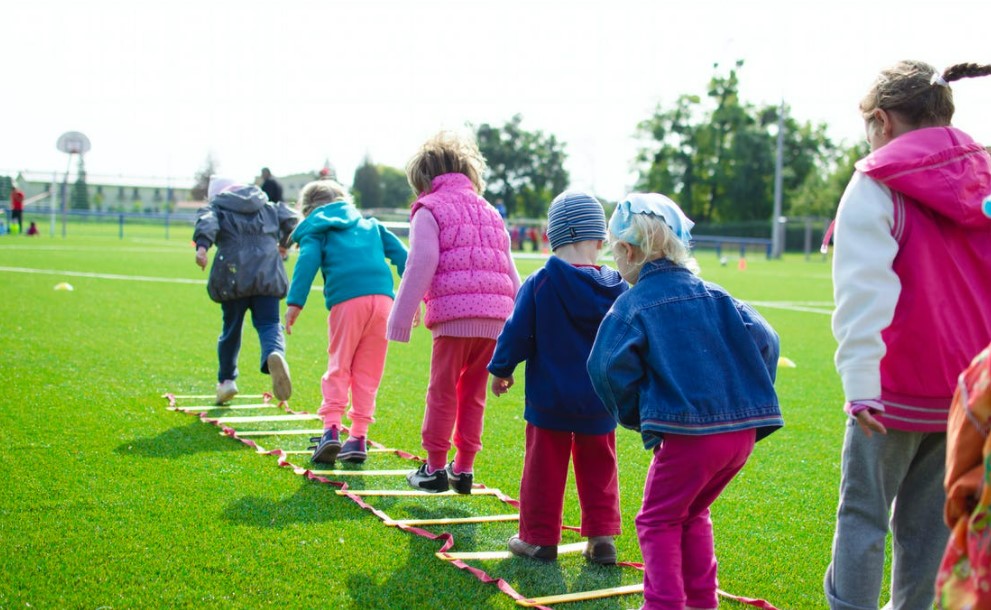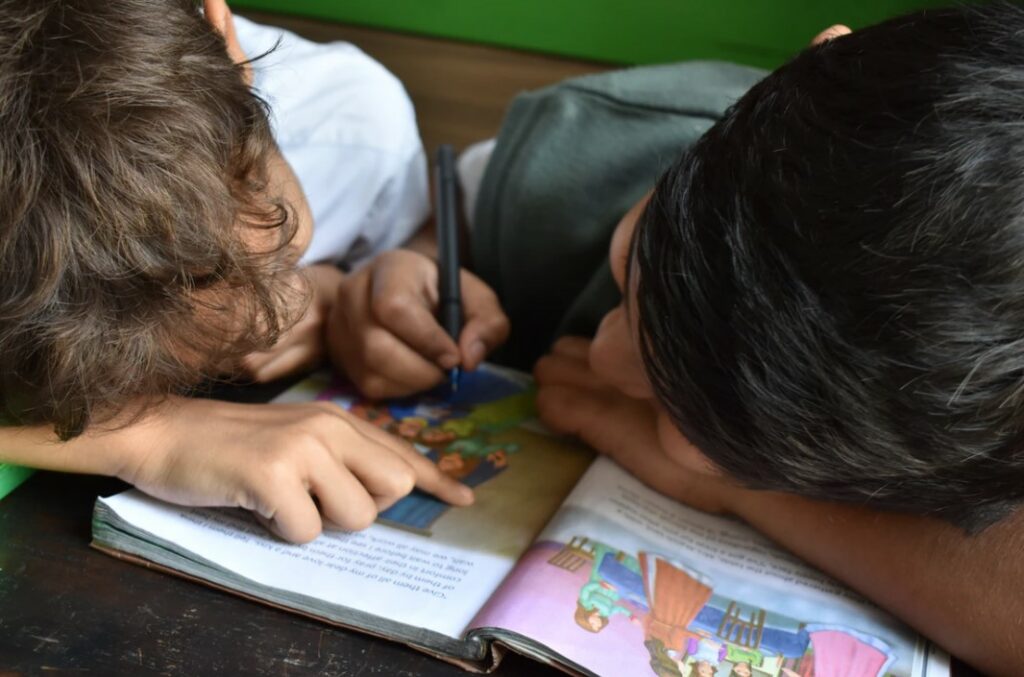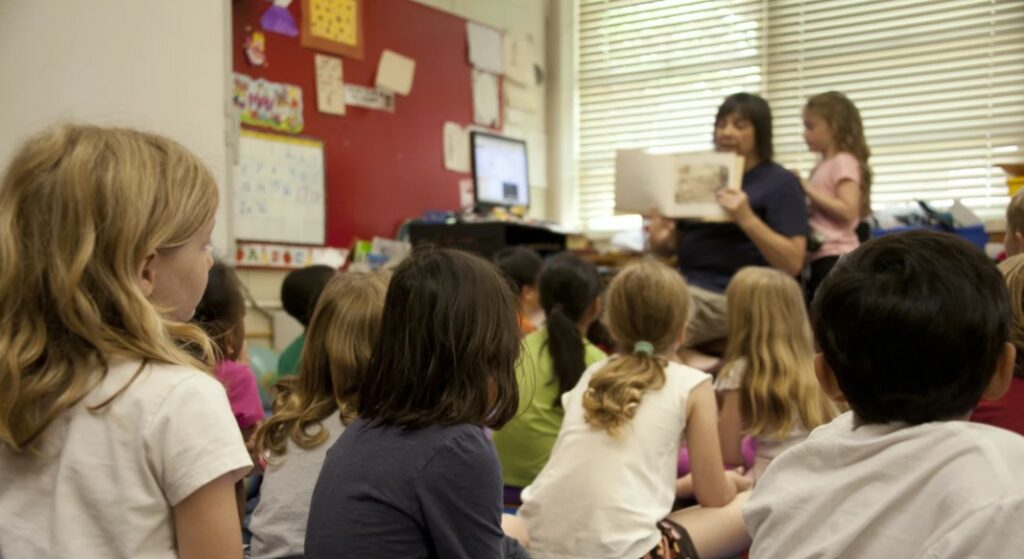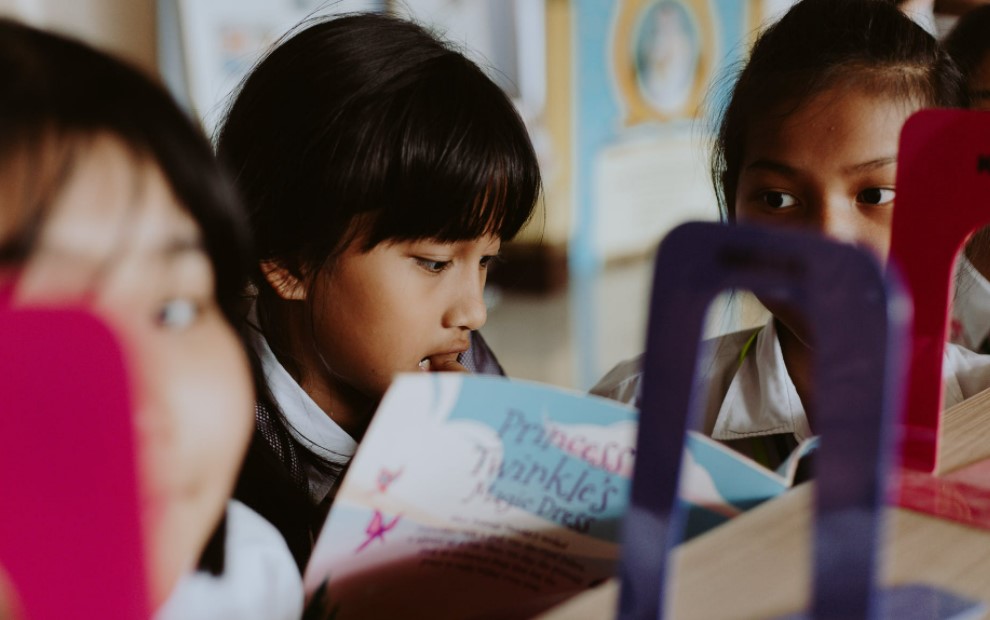
Indigenous Child Care Workforce Development Snapshot
Indigenous children are gifts from the creator. They come into this world to be nurtured, encouraged and supported. Children choose their parents and in return, their parents have an inherent responsibility to help them find their gifts so that they may flourish.
Historically, parents and extended family were the primary caregivers for all Indigenous children and the child’s first teachers. This way of living positions Indigenous parents as best suited to provide their children with knowledge of their histories, languages, customs, stories, ceremonies and rituals. This is the premise for quality child care for Indigenous children.
Past and current economic pressures have significantly changed the historical approach to Indigenous child care. Parents and extended family members are increasingly pressured to secure employment outside the home to provide for their children and families. While family and friends continue to be an option for child care, with increasing frequency Indigenous families have had to rely on child care options outside the family unit and, in some cases, outside of the community of residence.
As Indigenous communities make concerted efforts to address community needs in early learning and child care, they are not able to escape challenges similar to those they encounter dealing with elementary, secondary and post-secondary education that are due to Canada’s historic underfunding of Indigenous education.[1]
This report examines the child care system that exists for Indigenous children in Canada. It also explores the workforce, workforce needs and opportunities to strengthen and enhance child care for Indigenous children and their families.

The Current System
The early learning and child care system for Indigenous children and families in Canada falls within the shared jurisdictions of Indigenous Peoples, provincial governments and the federal government.
The current Indigenous early learning and child care system can be depicted by five concentric circles. The inner-most circle represents early learning and child care programs. These programs are supported by child and family support initiatives, staff networks/associations and Indigenous post-secondary institutions. The outer ring depicts the jurisdictions responsible for early learning and child care for Indigenous children and their families.

Figure 1 Indigenous Early Learning and Child-care System, Canada
With respect to education and training, Indigenous post-secondary institutions like those in Alberta, British Columbia and Ontario pride themselves on the design and development of culturally relevant, accessible and community responsive programs. They have become increasingly recognized and supported by provincial governments, making them well-positioned to deliver early childhood education programs for Indigenous children. In Ontario, Anishinabek Educational Institute, First Nations Technical Institute and Six Nations Polytechnic offer diploma programs in early childhood education, which is the credential required to work in provincially licensed early childhood centres.[2]
The Indigenous early learning and child care system in Canada has educator networking and staff support entities, although they may be few and far between. Groups such as the BC Aboriginal Child Care Society, the Ontario Aboriginal Head Start Association and Gijiikendaamin – First Nations Early Years Mentors, Treaty 3 Territory in Ontario are important for information and resource sharing, professional development and program promotion.
These core elements are the beginnings of the foundation for a system in early learning and child care. However, there is a long way to go to realize a consistent approach to:
- Program delivery;
- Equity in service provision for all communities;
- Indigenous language programming;
- Support for the design, development and delivery of culturally responsive programming;
- Targeted efforts to strengthen and ensure a qualified workforce;
- Administrative support services;
- Policy design and implementation; and
- Ensuring support for infrastructure and maintenance.
Federal and Provincial Support for Indigenous Early Learning and Child Care
The Government of Canada supports three main programs for Indigenous early learning and child care, administered by three different federal departments:
- The Aboriginal Head Start in Urban and Northern Communities program, established in 1995, is administered by the Public Health Agency of Canada. This program is designed to address the needs of Indigenous People living in urban and northern communities, First Nations living off-reserve, Métis and the Inuit. Projects are free to participants and are typically centre-based preschool programs operating between September and June. Sites operating centre-based programming must, in most cases, be licensed by their provincial/territorial jurisdiction and must therefore maintain the correct number of certified early childhood educators and ratios of teachers to children.[3]
- The Aboriginal Head Start on Reserve program administered by Indigenous Services Canada was established in 1998 as a locally controlled early intervention program primarily for preschoolers (aged three to six) of First Nations, Inuit and Métis families.[4] The First Nations Head Start Standards Guide provides a template for program design and implementation with no cost to participants and the guidelines are merely suggestions, unlike binding regulations for provincially licensed early childhood programs.[5]
- The First Nations and Inuit Child Care Initiative was established in 1995 with the goal of creating 6,000 child care spaces on First Nations and in the Territories. It was intended to provide culturally appropriate, affordable, quality child care services comparable to what is available to other Canadian children. In 1999, it was bundled into aboriginal human resource development agreements with First Nations and with service providers in the Territories to take advantage of the agreement holders’ delivery network. The program is administered by Employment and Skills Development Canada.[6]
An evaluation of the Aboriginal Head Start in Urban and Northern Communities program from 2011 to 2016 revealed a decrease in service provision over time. Key findings included:
- Programming affected by demographic changes as well as several barriers to access and delivery, including geographic location, limited capacity to serve students with special needs and transportation.
- The program currently supports 134 Head Start sites. The number and location of program sites has remained fairly constant since the program’s creation in 1995. Yearly program enrolment trends since 2006 have also remained generally stable at approximately 4,700 to 4,800 children aged six and under each year. In 2009-10, the program reached 4 percent of all Indigenous children aged six and under living off-reserve, with the greatest reach in the Northwest Territories (12.2%) and Quebec (11.5%).
- Program performance data show a decrease between 2013-14 and 2015-16 in the number of children that Head Start sites were able to serve. In 2013-2014, 27 percent of sites reported being at least five children under-capacity (i.e., having refused at least five children due to insufficient capacity), compared to 44 percent of sites in 2015-16. Similarly, 27 percent of sites had a wait list at the beginning of the school year in 2013-14 compared to 40 percent of sites in 2015-16. The average number of children on a wait list was higher in 2013-14 (average of 21 children) than in 2015-16 (average of 15 children).[7]
A 2019 report on Indigenous early childhood development in Canada confirmed a large proportion of Indigenous children do not have access to formal child care arrangements and cited a host of issues that are not being addressed. It found:[8]
- The Public Health Agency reports there were 88 projects serving a majority of First Nations children (approximately 55 percent of the off-reserve First Nations population), 57 projects with a majority of Métis children (approximately 19 percent of the Métis population), and 31 projects serving a majority of Inuit children (approximately 21percent of the Inuit population).
- Information from the Aboriginal Head Start on Reserve website indicates 14,000 First Nations children on reserve participated in a Head Start program (excluding B.C.), while the FNIGC reported in 2012 that approximately 36 percent of all First Nations children on reserve aged 11 and under had attended a program in the 2008-10 RHS. Data from 2008 from the since renamed department of Indian and Northern Affairs indicated 354 Head Start sites were funded in that year, providing services to 383 First Nations communities and 9,000 children.
- Funding has not kept pace with the rapidly growing Indigenous population and the cost of operating the sites has increased, particularly for training and resources for children with special needs such as autism, attention deficit hyperactivity disorder, speech and language difficulties, fetal alcohol spectrum disorders (FASD), developmental delays and mental health issues.[9]
Inuit Tapiriit Kanatami reports that the majority of early learning and child care programs in communities across Inuit Nunangat stem from the First Nations and Inuit Child Care Initiative and the Aboriginal Head Start in Urban and Northern Communities program. In 2017, it reported:
- There are 62 First Nations and Inuit Child Care Initiative-funded programs.
- There are 28 Head Start programs (including the integrated model that all Nunavik child care centres have created); and
- Funding for Inuit early learning and child care programs has not increased since programs were established 20 years ago.[10]
Effectiveness of Current Programs
To demonstrate the effectiveness and capacity of key programs, this report cites a number of sources.
At a national meeting regarding the federal First Nations and Inuit Child Care Initiative in 2017, the Assembly of First Nations revealed a key environmental challenge is matching available resources with demand. Communities with centres have sufficient space to support about one in five school children. With regulated allotments for infants, toddlers and preschoolers, centres must follow local policies to accept children given capacity limitations (space, staff, financial). The prevalence of special needs children requiring unique staff support magnifies the challenges in meeting local needs. Program funding is not based on actual cost needs but is a currently being managed on, 500 per space in all agreements. Centres that establish parental fees can expand their budgets, but at the cost of excluding families who cannot afford the fees. In some cases, fees are covered by other programs in the community. End-of-year deficits are[11] absorbed by band operations.[12]
A 2021 report on Indigenous early learning and child care in Alberta drew attention to three primary concerns: inadequate program funding; an increase in special needs children attending the programs, and; inadequate and unsafe facilities.[13]
In 2017, the Inuit Tapiriit Kanatami articulated needs to Employment and Social Development Canada regarding a lack of funding for early learning and child care — 10 communities had no licensed child care centres, another 27 were without Head Start programs, and all centres but one had wait lists.[14] The Inuit Tapiriit Kanatami recommendations included:
- Adequate, integrated, multi-year funding directly to Inuit organizations through transfer agreements to provide Inuit-defined high-quality early learning and child care programs in every community in Inuit Nunangut; and
- Capital funds to build new and renovate existing buildings and playgrounds, as determined by communities.[15]
The Indigenous Early Learning and Child Care Framework was created by the federal government, the Assembly of First Nations, the Inuit Tapiriit Kanatami and the Métis National Council to provide a mechanism to enhance and strengthen current programs and services. Following the initial year of implementation in 2018-19, results were found to include:
- Approximately 460 First Nations received new funding for a range of early learning and child care needs;
- Increased funding to 73 existing services in Inuit communities; and
- New Métis-specific early learning and child care services.[16]
Setting aside the three main federal programs in early learning and child care, provincial jurisdiction comes into effect for those First Nations communities that operate provincially regulated and provincially licensed child care centres. Provincial regulation also comes into effect when children and families need to access educational programming and supports provided by provincial schools, school boards and other educational support services organizations.
Federal and provincial jurisdictional lines (or reserve boundaries) can result in access to services or lack of service provision. In their 2019 report on Indigenous early childhood development in Canada, authors Regine Halseth and Margo Greenwood write:
There are also unique structural and systemic factors that enable or hinder Indigenous children’s development, including lack of community-focused, culturally safe and accessible health, education, child welfare, and social services systems; legislation, policies and agreements that contribute to (un)healthy family or community environments, and; unresolved jurisdictional disputes over which level of government is responsible for funding programs and services for Indigenous Peoples.[17]
A 2021 report titled Structural Challenges & Inequities in Operating Urban Indigenous Early Learning and Child Care Programs in British Columbia found that funding for urban early learning and child care programs has not kept pace with a rapidly growing urban Indigenous population. [18][19]
The business model for early learning and child care for Indigenous children is not unlike the business model prevalent throughout mainstream Canada. As of 2019, 72 percent of child care spaces in Canada were not-for-profit centres.[20] Indigenous early learning and child care, like other levels of education, are largely dependent upon federal grants and subsidies.
The flow of funding from Treasury Board to Indigenous communities, coupled with the historic lack of inter-departmental co-ordination, results in inconsistencies in service provision, accessibility and financial support for Indigenous early learning and child care programs across jurisdictions.

The Workforce for Indigenous Early Learning and Child Care
There is no single data source to investigate the state of the existing workforce, workforce needs or compensation for early learning and child care for Indigenous populations.
The Aboriginal Head Start Standards Guide suggests staff for Head Start programs may include director/supervisor/manager, teachers and/or early childhood educators, cook, bus driver, janitor/custodian, bookkeeper/clerk, cultural teacher, curriculum developer and part-time replacements, as well as elders, parent(s)/legal guardian(s)/extended family and volunteers.[21]
A Statistics Canada report in 2021 about gender roles in Indigenous early learning and child care revealed that although occupations are female-dominated, First Nations early childhood educator assistants (ECEAs) and child care practitioners (CCPs) were more likely to be men than non-Indigenous ECEAs and CCPs. Moreover, both First Nations and Inuit ECEAs and CCPs were more likely to be paid employees, but less likely to work full time compared with their non-Indigenous counterparts. Métis CCPs were also less likely to work full time compared with non-Indigenous CCPs. Differences were also observed across industry sectors. For example, a higher proportion of Indigenous early learning and child care workers than their non-Indigenous counterparts were employed in the social assistance sector. [22][23]
The Assembly of First Nations issued a report in 2017 on the current work force in the Indigenous early learning and child care system in Canada. The report states:
Child care practitioners are part of a well-defined area of practice with each region having their own certification pathways. Every discussion regarding challenges to the First Nations and Inuit Child Care Initiative includes difficulties in retaining staff that are underpaid. Comments such as “In our province, daycare workers are making less than the janitors” describe the problem well. One participant noted that it is way past due to compensate elders for their time because they are teachers when they are in the daycare. Part of this would be to have a process to certify or accredit their expertise. It is a fact of life that daycare workers are dealing with special needs (regardless of the lack of access to diagnostic services) and any specialized training is valued, although probably inadequate. On a broader scale, workers must educate the community that daycares are not just babysitting centres but are an important early learning environment that can help overcome “a history of trauma, residential school effects, families and parents who are overwhelmed with special needs, autism, FASD and other issues.[24]
The Inuit Tapiriit Kanatami stressed in 2014 the need for increased funding for pay parity between early childhood educators and teachers, ongoing training and professional development.[25] Their submission to Employment and Social Development Canada in 2017 stated:
- There needs to be increased funding per early learning and child care space to pay staff livable wages and benefits; and
- Staff have little or no training to support these children, nor is there enough specialized staff to support them (from health, social services, education or other departments).[26]
The organization stressed the need for specialized training to address unique needs of the population, recommending Inuit-specific early childhood development curriculum, program, materials and teaching tools that are trauma-informed and grounded in Inuit knowledge and Inuit approaches to child rearing, nurturing and learning.[27] The need for a trained workforce for the Indigenous early learning and child care system in Canada is challenged with addressing a spectrum of diverse needs due to the negative impacts of Indian Residential schools.[28]
The Halseth and Greenwood report uncovered a host of human resource challenges for Indigenous communities delivering early learning and child care programs. They include:
- Requirements for early learning teachers to attain standardized qualifications and be licensed;
- Prohibitive costs associated with ensuring infrastructure for such programs and meeting standards and staffing requirements; and
- The large geographical distances between Indigenous communities and the post-secondary institutions that provide early learning education .[29]
The Structural Changes report reinforces the need for unique training for Indigenous early learning and child care sites, stating:
For over 100 years, Indigenous children as young as four were forcibly removed from their homes and communities and placed in church‐run residential and industrial schools (Truth and Reconciliation Commission of Canada, 2015; Wilk et al., 2017). The ongoing impacts of colonialism mean that, compared to non-Indigenous children in Canada, Indigenous children are more likely to grow up in families affected by intergenerational trauma (Reading & Wien, 2013) and the multiple and interrelated downstream effects of poverty (Hajizadeh et al., 2018), and to be removed from their homes, cultures, and communities by the contemporary child welfare system (Tait et al., 2013).[30]
The report also concluded funding for Indigenous early learning and child care programs has not kept pace with a rapidly growing urban Indigenous population or increasing operational costs, including infrastructure costs, a living wage with benefits for staff, and the training and resources required to support children with diverse abilities.[31]
The 2021 report on Indigenous early learning and child care in Alberta revealed:
- Some participants stated they hold multiple roles in either the daycare or Head Start program. For example, one person mentioned she was the bus driver, the janitor and a child care worker. She said she did these multiple positions for two reasons — the pay was low and doing more than one job made it possible for her to support her family, and the budget would not allow a full-time person for each of these jobs;
- There was a high turnover of staff reported because of low wages;
- Lack of training meant an inability to include special needs children;
- A dedicated position for maintenance and janitorial staff was lacking in many facilities. Generally, teachers and other staff members were responsible for doing the janitorial work; and
- Child care workers are expected to upgrade and maintain their certification. The situation was seen to be untenable because low wages meant they were not able to pay for upgrading. Also, there was no money for staff training in the budget.[32]
In addition to human resource challenges like these, in Ontario, once a person achieves the educational requirements to become an early childhood educator, they must register with the province’s professional association to use the title of ECE, which requires payment of annual fees.[33] This creates an added financial burden for persons working in low-paid positions.
The evaluation of the Aboriginal Head Start in Urban and Northern Communities program from 2011 to 2016 revealed:
- Over the past five years, the program has used strategic funds to support ECE training, especially in the field of special needs, as well as unused funds to enable the purchase of transportation vehicles. Evidence indicates there is a continued need for these supports.
- In 2013-14, 28.3 percent of sites reported staff turnover was a concern. This proportion increased to 36.8 percent in 2015-16. The most frequently cited reasons for staff departures in 2015-16 were:
- Pursued other career opportunities (57% – up from 43% in 2013-14);
- Left for personal/family reasons — unspecified (52% – up from 43% in 2013-14); and
- Left for a position with a higher salary (50% – up from 23% in 2013-14).[34]
The First Nations Head Start Standards Guide provides suggestions for workplace requirements for both the learning environment and human resources, whether located on reserve or in urban and northern communities. The following chart contains suggested qualifications for directors and persons responsible for children’s programming.
| Position | Qualifications |
| Director |
|
| Head Start workers |
|
The guide’s section on provincial/territorial government regulations (section 8) contains more stringent information on expectations for staff qualifications, which vary from region to region. The discrepancy in requirements for staff qualifications from those listed above may be a reflection of local level staffing qualifications, whereas requirements in section 8 can be viewed as more aspirational in nature without programs having the financial support to achieve the desired qualifications. Having program operators who achieve provincial and territorial government regulations for staffing requirements would enhance the level of quality programming for children.
This same scenario holds true for ratios of care. The First Nations Head Start Guide encourages communities to establish policies for staff-to-child ratios that, essentially, mirror regulations from their respective provinces or territories.[36] With respect to First Nations operating provincially licensed and supported child care centres, programs must comply with provincial regulations that vary from jurisdiction to jurisdiction.
The research has uncovered numerous challenges that are straining the workforce, everything from recruitment and retention to wage parity, access and funding support for training and upgrading, the need for specialized training, and the need for adequate, sustainable and long-term funding. The staff complement, staff qualifications and ratios of care significantly impact not only the quality of care but also appropriate compensation levels. Efforts must be taken to create a baseline of data nation-wide to ascertain the extent of needs regarding staffing, staff qualifications and compensation levels. As programs and efforts continue to evolve, it is imperative that change be supported with significant increased financial contributions if the goal is to eliminate barriers in achieving and maintaining a highly skilled workforce for the early learning and child care profession.

Moving Forward
A qualified workforce for early learning and child care requires clear pathways with financial supports to obtain the required credentials, and there are some in place:
- The federal Post-Secondary Student Support Program is a financial catalyst for an educated workforce of eligible First Nations and Inuit post-secondary students.[37] However, Treasury Board limitations mean the current numbers of students wanting to attend post-secondary education cannot be accommodated;
- Métis students are supported by the Métis Nation Post-Secondary Education Strategy;[38] and
- The Métis Nation Early Learning and Child Care Accord identifies a specific commitment to support training in early childhood education.[39]
The Government of New Brunswick can be commended for the 2021 announcement to help vulnerable residents by making available full tuition for personal support workers and human services positions, which includes diploma and certificate programs in early childhood education for those working in licensed child care settings.[40],[41] This type of strategy is what’s needed to achieve a qualified workforce for Indigenous early learning and child care initiatives.
Health Canada and the Public Health Agency of Canada have acknowledged that low levels of remuneration make hiring and retention of qualified and trained staff challenging. Recruitment challenges are compounded by the need for Aboriginal Head Start in Urban and Northern Communities -trained and knowledgeable about Indigenous cultures and languages. For remote communities, the availability of qualified staff is even more limited. In turn, high turnover and staff burnout can affect the quality and continuity of programming.[42][43]
While not specific to employment needs, the First Nations Early Learning and Child Care Framework documents the federal commitment of broad-based financial support for an Indigenous-controlled system of early learning and child care.
Programs, services and supports for First Nations children and families are funded in varying degrees and levels across the country by both federal and provincial governments. This framework argues for a fund-the-system approach, which considers early learning and child care as an integrated system with interconnected parts based on community needs and priorities, because First Nations cultures, communities and nations must be supported[44][45]
To solidify the commitment, for 10 years beginning in 2018 the federal government is spending up to $1.7 billion to strengthen existing child care programs under the umbrella of Aboriginal Head Start Urban and Northern Communities, Aboriginal Head Start on Reserve and the First Nations and Inuit Child Care Initiative.[46]
Any and all enhancements to current programs and services are positive, however, it is important not to lose sight of the fact that there continues to be a significant number of communities without access to child care services.
How will the current federal financial commitment address historically underfunded programs in Indigenous early learning and child care? How will the commitment facilitate capacity building in communities currently without child care services? It is not clear that the federal funding commitment will ensure a highly educated and qualified early learning and child care workforce.

In Closing
The inherent responsibility of Indigenous Peoples to provide the best possible care will continue to fuel their desire to control the design, development and delivery of early learning and child care programs and services to support Indigenous children.
Indigenous worldviews, the impacts of colonialism and the legacies of Indian Residential Schools will, for generations to come, define the unique needs for programs and delivery from community to community and region to region. To address the breadth and quality of programming, and as a natural progression, would it make sense to broaden collaboration with Indigenous organizations involved in education?
A system of Indigenous early learning and child care in Canada requires sufficient and sustainable funding under a unique funding model that takes into consideration the histories and the linguistic, cultural, social, spiritual, educational and economic realities and aspirations of Indigenous Peoples. Indigenous worldviews are the foundation to educate and train a workforce to address the unique needs of Indigenous children, their families and communities. Building a system for Indigenous populations cannot be a mirror image of what exists in provincial mainstream populations.
Indigenous Peoples need to be the driving force at all levels of government where decisions are being made, from consultation and policy design and development to determining funding models, implementation, system supports, education and training, data and research. Ultimately, the design of an early learning and child care system for Indigenous children and families could include — but must not be limited to — the following components:
- Formal and informal child care options;
- Staff designated to child development assessments;
- Indigenous language programming;
- Curriculum and policy development specialists;
- Access to speech and language pathologists and audiologists;
- Access to medical supports;
- Parental programming (holistic approach to child development);
- Ongoing professional development for early learning and child care staff;
- Transportation support;
- Administrative, human resources and financial support;
- Partnerships with the local school/school board for shared support services; and
- Partnerships with community support organizations.
Considerable work is needed to conceptualize the existence of an accessible, affordable, responsive, culturally relevant early learning and child care system that is designed to embrace the aspirations of Indigenous Peoples in Canada. To what extent will the federal commitment support the creation of a responsive Indigenous early learning and child care system, one that addresses the needs now and for seven generations into the future?
- Drummond, D., and Kachuck Rosenbluth, E. (2013). Working Paper 49, The Debate on First Nations Education Funding: Mind the Gap. Queen’s University. https://qspace.library.queensu.ca/bitstream/handle/1974/14846/Drummond_et_al_2013_Debate_on_First_Nations.pdf?sequence=1; and Assembly of First Nations (n.d.). Fact sheet: First Nations Education Funding. https://www.afn.ca/uploads/files/education/fact_sheet_-_fn_education_funding_final.pdf ↑
- See Ministry of Colleges and Universities (n.d.). Indigenous Institutes. Government of Ontario. https://www.ontario.ca/page/indigenous-institutes; and Indigenous Adult and Higher Learning Association (n.d.). http://iahla.ca/ ↑
- Health Canada and the Public Health Agency of Canada. (2017). Evaluation of the Aboriginal Head Start in Urban and Northern Communities Program 2011-2012 to 2015-2016, p. 2. Government of Canada. https://www.canada.ca/content/dam/hc-sc/documents/corporate/transparency/corporate-management-reporting/evaluation/2011-2012-2015-2016-aboriginal-head-start-urban-and-northern-communities-program/ahsunc-apacu-eng.pdf ↑
- Public Health Agency of Canada. (1998). Aboriginal Head Start Urban and Northern Initiative. Government of Canada. https://www.canada.ca/en/public-health/services/health-promotion/childhood-adolescence/publications/aboriginal-head-start-urban-northern-initiative.html#a2 ↑
- Indigenous Services Canada. (n.d.). First Nations Head Start – Standards Guide. Government of Canada. https://www.sac-isc.gc.ca/eng/1582215017700/1582215088300#_114 ↑
- Employment and Social Development Canada. (2018). Audit of Social Infrastructure Funding – First Nations and Inuit Child Care Initiative, p. 1. Government of Canada. https://www.canada.ca/content/dam/canada/employment-social-development/corporate/reports/audits/first-nations-inuit-child-care-initiative/Audit-Report-First-Nations-EN.pdf ↑
- Health Canada and the Public Health Agency of Canada. (2017). Evaluation of the Aboriginal Head Start in Urban and Northern Communities Program 2011-2012 to 2015-2016, p. 20-21. Government of Canada. https://www.canada.ca/content/dam/hc-sc/documents/corporate/transparency/corporate-management-reporting/evaluation/2011-2012-2015-2016-aboriginal-head-start-urban-and-northern-communities-program/ahsunc-apacu-eng.pdf ↑
- Halseth, R., and Greenwood, M. (2019). Indigenous early childhood development in Canada: Current state of knowledge and future directions, p. 5. National Collaborating Centre for Aboriginal Health. https://www.nccih.ca/docs/health/RPT-ECD-PHAC-Greenwood-Halseth-EN.pdf ↑
- Ibid., p. 39-40. ↑
- Employment and Social Development Canada. (2019). Investing in our future: National Progress Report on Early Learning and Child Care 2017–18, p. 4. Government of Canada. https://www.canada.ca/content/dam/esdc-edsc/documents/programs/reports/1979-elcc-nati-prog-report2019-en.pdf ↑
- ↑
- Assembly of First Nations. (2017). National Meeting on Indigenous Early Learning and Child Care Framework. https://www.afn.ca/wp-content/uploads/2018/10/AFN-Summary-Report-July-2017-Nat-Mtg-on-Indigenous-Early-Learning-Child-Care-Framework_ENG.pdf#:~:text=The%20Assembly%20of%20First%20Nations%20%28AFN%29%20hosted%20a,a%20separate%20track%20from%20the%20Federal-Provincial%2FTerritorial%20ELCC%20Framework ↑
- Alberta First Nations Information Governance Centre. (2021). Indigenous Early Learning & Child Care (IELCC): Environmental Scan – Alberta Region, p. 5 https://www.afnigc.ca/main/includes/media/pdf/digital%20reports/IELCC%20Environmental%20Scan%20FINAL.pdf ↑
- Inuit Tapiriit Kanatami. (2017). Inuit Submission to Employment and Social Development Canada Regarding National Indigenous Early Learning, p. 13, 17. https://www.itk.ca/wp-content/uploads/2018/04/National-Indigenous-Early-Learning-and-Child-Care-Report.pdf ↑
- Ibid., p. 29-31. ↑
- Employment and Social Development Canada. (2019). Investing in our future: National Progress Report on Early Learning and Child Care 2017–18, p. 8. Government of Canada. https://www.canada.ca/content/dam/esdc-edsc/documents/programs/reports/1979-elcc-nati-prog-report2019-en.pdf ↑
- Halseth, R., and Greenwood, M. (2019). Indigenous early childhood development in Canada: Current state of knowledge and future directions, p. 5-6. National Collaborating Centre for Aboriginal Health. https://www.nccih.ca/docs/health/RPT-ECD-PHAC-Greenwood-Halseth-EN.pdf ↑
- ↑
- 19581-Article Text-22538-1-10-20210707.pdf, page 1 ↑
- Childcare Resource and Research Unit. (2022). Building capacity in the non-profit child care sector, p. 6. Childcarecanada.org. https://childcarecanada.org/sites/default/files/SERIES-Paper-2-Building-capacity-non-profit.pdf ↑
- Health Canada. (n.d.). First Nations Head Start Standards Guide, p.20. Government of Canada. https://www.sac-isc.gc.ca/DAM/DAM-ISC-SAC/DAM-HLTH/STAGING/texte-text/family-health-head-start-ahsor_fn-standards-guide_1582214848065_eng.pdf ↑
- ↑
- Statistics Canada. (2021). Indigenous and non-Indigenous early learning and child care workers in Canada, p. 11. Government of Canada. https://www150.statcan.gc.ca/n1/en/pub/36-28-0001/2021008/article/00005-eng.pdf?st=mSoj2D1P ↑
- Assembly of First Nations. (2017). National Meeting on Indigenous Early Learning and Child Care Framework, p. 6. https://www.afn.ca/wp-content/uploads/2018/10/AFN-Summary-Report-July-2017-Nat-Mtg-on-Indigenous-Early-Learning-Child-Care-Framework_ENG.pdf#:~:text=The%20Assembly%20of%20First%20Nations%20%28AFN%29%20hosted%20a,a%20separate%20track%20from%20the%20Federal-Provincial%2FTerritorial%20ELCC%20Framework ↑
- Inuit Tapiriit Kanatami. (2014). Assessing the Impact of the First Nations and Inuit Child Care Initiative (FNICCI) across Inuit Nunangat, p. 4. https://www.itk.ca/wp-content/uploads/2016/07/2014_Report_FNICCI_Impacts_Inuit_Nunangat.pdf#:~:text=Quality%2C%20Inuit%20early%20child%20care%20programs%20are%20vital,regional%20economies%20across%20Inuit%20Nunangat.%20This%20document%20will%3A ↑
- Inuit Tapiriit Kanatami. (2017). Inuit Submission to Employment and Social Development Canada Regarding National Indigenous Early Learning, p. 15, 30. https://www.itk.ca/wp-content/uploads/2018/04/National-Indigenous-Early-Learning-and-Child-Care-Report.pdf ↑
- Ibid., p. ii. ↑
- National Centre for Truth and Reconciliation. (n.d.). National Centre for Truth and Reconciliation Reports. https://nctr.ca/records/reports/ ↑
- Halseth, R., and Greenwood, M. (2019). Indigenous early childhood development in Canada: Current state of knowledge and future directions, p. 51. National Collaborating Centre for Aboriginal Health. https://www.nccih.ca/docs/health/RPT-ECD-PHAC-Greenwood-Halseth-EN.pdf ↑
- 19581-Article Text-22538-1-10-20210707.pdf, page 2 ↑
- Ibid., p. 4. ↑
- Alberta First Nations Information Governance Centre. (2021). Indigenous Early Learning & Child Care (IELCC): Environmental Scan – Alberta Region, p. 15, 19-21. https://www.afnigc.ca/main/includes/media/pdf/digital%20reports/IELCC%20Environmental%20Scan%20FINAL.pdf ↑
- College of Early Childhood Educators. (n.d.). Welcome to the College of Early Childhood Educators. https://www.college-ece.ca/ ↑
- Health Canada and the Public Health Agency of Canada. (2017). Evaluation of the Aboriginal Head Start in Urban and Northern Communities Program 2011-2012 to 2015-2016, p. 7, 42. Government of Canada. https://www.canada.ca/content/dam/hc-sc/documents/corporate/transparency/corporate-management-reporting/evaluation/2011-2012-2015-2016-aboriginal-head-start-urban-and-northern-communities-program/ahsunc-apacu-eng.pdf ↑
- Health Canada. (n.d.). First Nations Head Start Standards Guide, p.7. Government of Canada. https://www.sac-isc.gc.ca/DAM/DAM-ISC-SAC/DAM-HLTH/STAGING/texte-text/family-health-head-start-ahsor_fn-standards-guide_1582214848065_eng.pdf ↑
- Ibid., p. 7. ↑
- Indigenous Services Canada. (n.d.). Post-Secondary Student Support Program. Government of Canada. https://sac-isc.gc.ca/eng/1100100033682/1531933580211 ↑
- Indigenous Services Canada. (n.d.). Métis Nation Post-Secondary Education Strategy. Government of Canada. https://sac-isc.gc.ca/eng/1578855031863/1578855057804 ↑
- Government of Canada. (2019). Métis Nation Early Learning & Child Care (ELCC) Accord. https://www.canada.ca/content/dam/esdc-edsc/documents/programs/indigenous-early-learning/Metis_Nation_ELCC_Accord-EN.pdf ↑
- Department of Post-Secondary Education, Training and Labour. (2021). Full tuition costs to be covered for personal support workers and human services counsellors. Government of New Brunswick. https://www2.gnb.ca/content/gnb/en/news/news_release.2021.08.0577.html?fbclid=IwAR3PUOIvvpb5kIhKP4Wjk1kZ3RmLXnCpkyHPtB6GOpjwTmvyH1-Xt24el6E ↑
- Department of Education and Early Childhood Development. (2021). Early Childhood Educator Tuition Reimbursement Program. Government of New Brunswick. https://www2.gnb.ca/content/dam/gnb/Departments/ed/pdf/ELCC/ECHDPE/application-guidelines.pdf ↑
- ↑
- Health Canada and the Public Health Agency of Canada. (2017). Evaluation of the Aboriginal Head Start in Urban and Northern Communities Program 2011-2012 to 2015-2016, p. 42. Government of Canada. https://www.canada.ca/content/dam/hc-sc/documents/corporate/transparency/corporate-management-reporting/evaluation/2011-2012-2015-2016-aboriginal-head-start-urban-and-northern-communities-program/ahsunc-apacu-eng.pdf ↑
- ↑
- Assembly of First Nations. (2017). National Meeting on Indigenous Early Learning and Child Care Framework, p. 10. https://www.afn.ca/wp-content/uploads/2018/10/AFN-Summary-Report-July-2017-Nat-Mtg-on-Indigenous-Early-Learning-Child-Care-Framework_ENG.pdf#:~:text=The%20Assembly%20of%20First%20Nations%20%28AFN%29%20hosted%20a,a%20separate%20track%20from%20the%20Federal-Provincial%2FTerritorial%20ELCC%20Framework ↑
- Employment and Social Development Canada. (n.d.). Indigenous Early Learning and Child Care. Government of Canada. https://www.canada.ca/en/employment-social-development/programs/indigenous-early-learning.html ↑







